You’ll find loads of brilliant food to try when your ship stops at a Mediterranean port
Start in Italy – grab some crispy arancini and proper cacio e pepe pasta, then treat yourself to fresh Sicilian cannoli filled right in front of you.
In Greece, you can’t go wrong with a hearty moussaka or anchovies caught that morning and cooked the local way. See our guide to the top 10 Greek Islands worth getting off your cruise for.
Spain’s got amazing gambas al ajillo (garlic prawns) and proper jamón ibérico ham.
Cool off with some creamy gelato in classic flavours, and leave room for a lovely panna cotta or sweet torrone.
Here’s our list of the top 25 authentic Mediterranean foods waiting for you to try.
Classic Italian Arancini (Rice Balls)
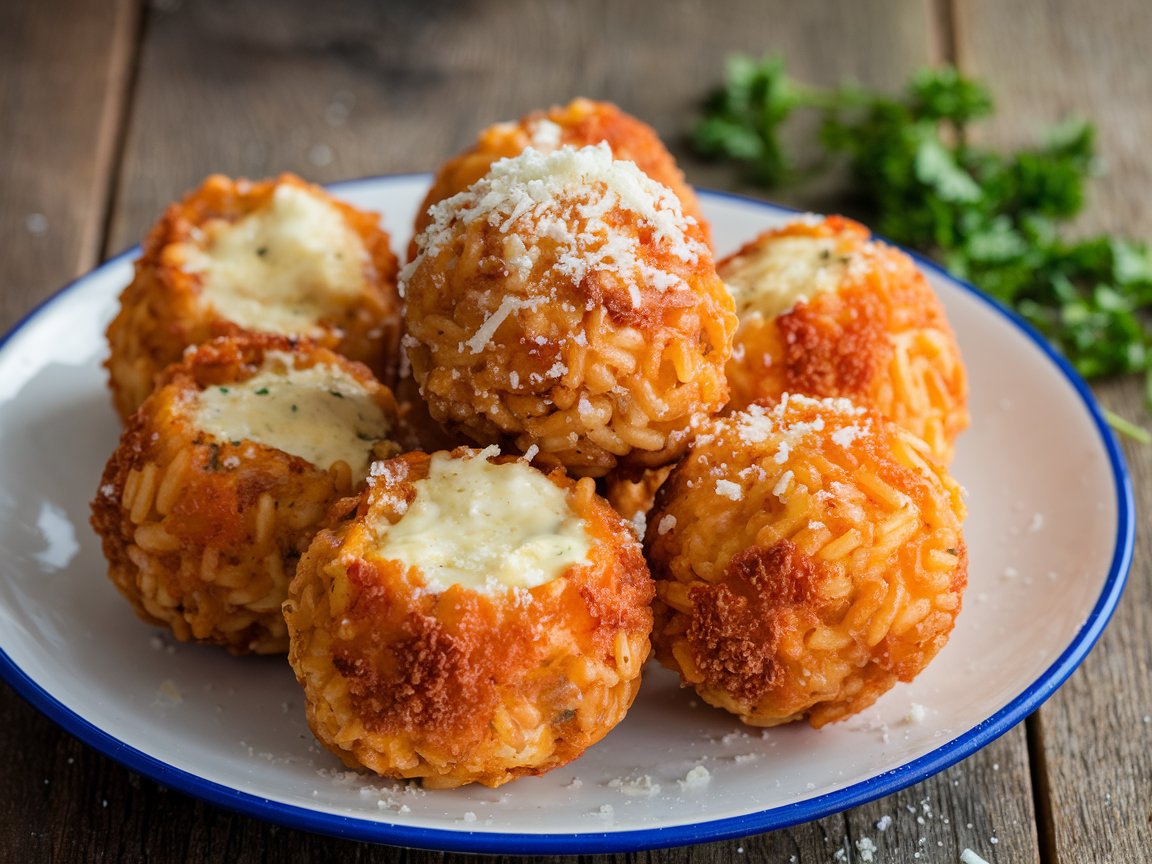
👉 Click here to get the recipe for: Classic Italian Arancini Rice Balls
The Sicilian streets are full of arancini – those brilliant golden rice balls that locals and visitors alike can’t get enough of. These crunchy beauties begin with Arborio rice simmered in chicken broth, then mixed up with eggs and cheese before being rolled into balls. Inside, you’ll find a lovely surprise: usually it’s a hearty meat ragù with peas, though you might come across versions stuffed with mushrooms, eggplant, or sweet ricotta.
If you’re wandering around cruise ports, keep an eye out for these handy snacks. Look for their distinctive golden-brown coating, made by rolling each ball in breadcrumbs and deep-frying until crisp. When done right, arancini give you that perfect crunch on the outside before you reach the lovely chewy rice and tasty filling. Best enjoyed straight away while they’re hot and crunchy, with a bit of warm marinara sauce on the side.
Authentic Roman Cacio E Pepe
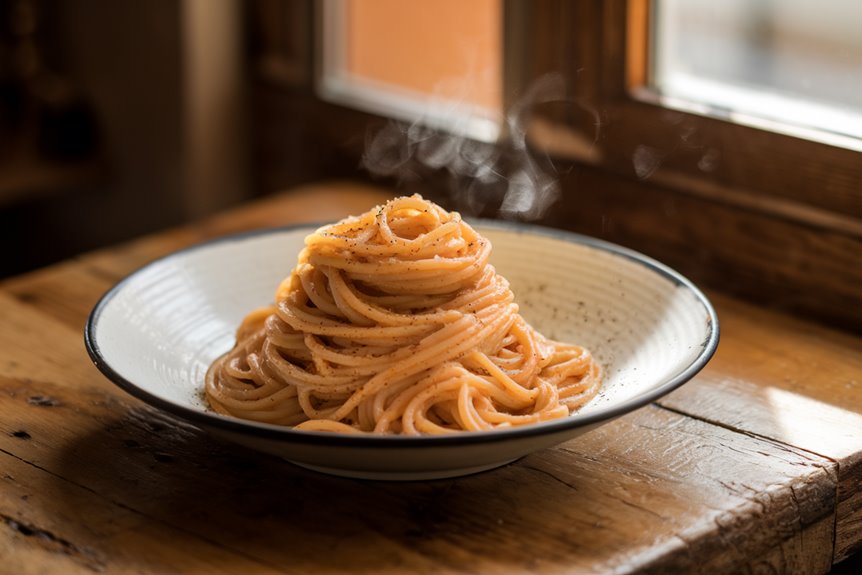
👉 Get the recipe for Authentic Roman Cacio E Pepe
When you get off your cruise ship at Port of Civitavecchia, and head into Rome, you’ll find cacio e pepe shows off Italian cooking at its simplest. This proper Roman pasta needs just three things: pecorino romano cheese, black pepper, and pasta (usually spaghetti or tonnarelli). Though it might look straightforward, getting it right takes spot-on technique and top-notch ingredients.
- Don’t fall for recipes that chuck in butter, olive oil, or cream – proper cacio e pepe never has these in it.
- The sauce gets creamy just from mixing the pecorino romano with starchy pasta water the right way.
- Getting it right comes down to the “risottare” method, which creates that silky smooth texture.
- You can tell it’s the real deal when the sharp, salty pecorino romano and loads of black pepper give you that bold, proper taste.
Sicilian Cannoli

👉 Get the recipe for Sicilian cannoli
Want to taste proper Sicilian cannoli? These delightful pastry shells are one of Italy’s best-loved treats, and Sicily is where they truly shine. In Palermo, especially at San Lorenzo market, you’ll spot these beauties filled with sheep’s milk ricotta cream and topped with candied orange or cherry.
Watch out for the touristy spots – they’re not the real thing. A proper cannolo (that’s what one is called) should be about 4-5 inches long, and the key is that it’s filled just when you’re ready to eat it.
The best time to try them is between autumn and spring when the sheep’s milk is at its finest. Keep an eye out for shells that use the traditional bits and bobs: 00 flour, wine, and either cocoa powder or cinnamon. The filling ought to be fresh sheep’s ricotta sweetened with icing sugar and given a lovely touch with rose or orange flower water.
Traditional Greek Moussaka
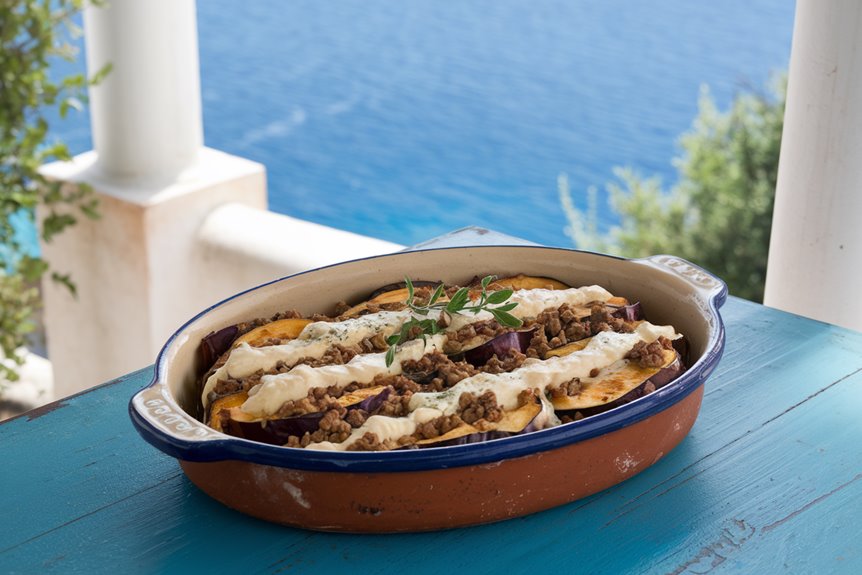
👉 Get the recipe for Traditional Greek Moussaka
Want proper Greek comfort food? You can’t beat moussaka – it’s an absolute legend of Greek cooking. This layered beauty is all about soft aubergines, spiced meat sauce and a gorgeous creamy bechamel on top, sitting nicely on a bed of potato slices.
- The potato base works brilliantly – it holds everything up and soaks in all those lovely meat juices
- The meat sauce is something special, with warm cinnamon and nutmeg giving it that proper Mediterranean taste
- Those aubergine layers drink up the rich tomato sauce like nobody’s business
- On top, you’ve got that amazing bechamel sauce with egg yolks and cheese, which turns golden-brown and delicious
If you’re at a Greek port like Piraeus Port, close to Athens, give this brilliant dish a try – it shows just how good traditional Greek cooking can be.
Here is a fabulous recipe typical of a Greek Port: Chicken with Lemon Rice.
Fresh Mediterranean Gelato
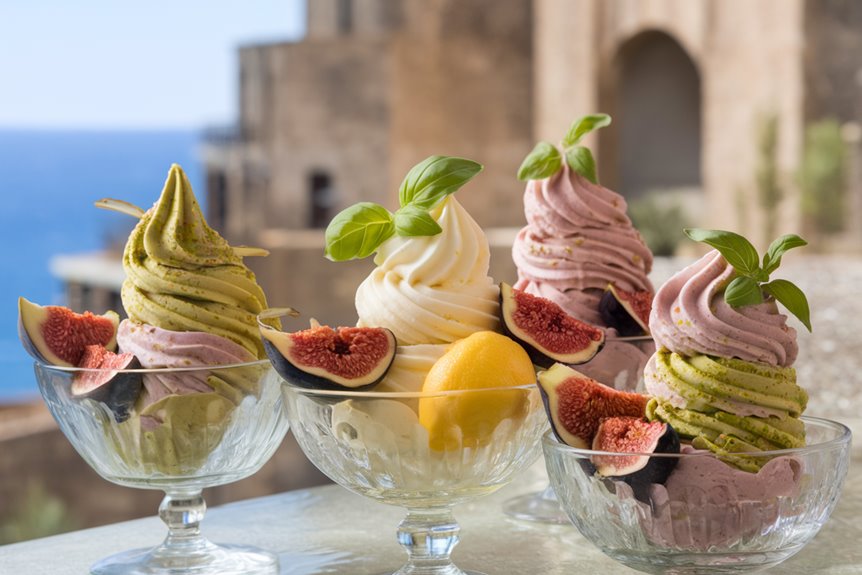
After filling up on hearty Greek dishes like moussaka, you’ll want to grab Italy’s favourite frozen treat – gelato. You can spot the real deal when you see metal tins and natural, subtle colours instead of bright artificial ones. Keep an eye out for signs saying “Produzione Propria” or “Nostra Produzione” – that means they make it themselves.
You can’t go wrong with classic flavours like nocciola (hazelnut), cioccolato (chocolate), and fragola (strawberry), but it’s worth trying something different too. In Rome, pop into FataMorgana and try their Kentucky flavour – a brilliant mix of cinnamon, dark chocolate, and tobacco.
For the best taste, pick two flavours that go well together. The real stuff has less fat than regular ice cream, usually between 1-10%. You’ll pay around 1.5-4 euros per serving, with extra for toppings.
Spanish Paella
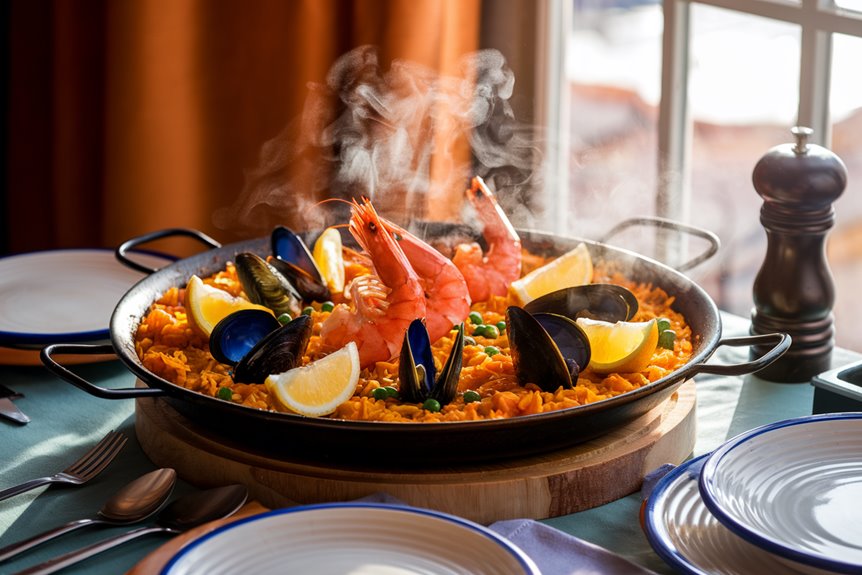
The best Spanish paella can be found at proper restaurants along the Mediterranean coast. You’ll spot this famous dish coming straight from large, shallow pans, where saffron-infused rice makes a golden base for loads of tasty proteins and veg. When you get paella, keep an eye out for the prized crusty bottom layer called socarrat – it forms when the rice is cooked carefully without stirring.
- Pick a restaurant that uses traditional Bomba or Calasparra rice, as these types soak up all the lovely flavours
- Go for dishes that mix land and sea ingredients, like chorizo with seafood
- You’ll see brilliant colours from smoked paprika, saffron, and fresh vegetables
- Join in the shared eating tradition by digging in from the same pan, just like the locals have done for ages
Homemade Greek Baklava
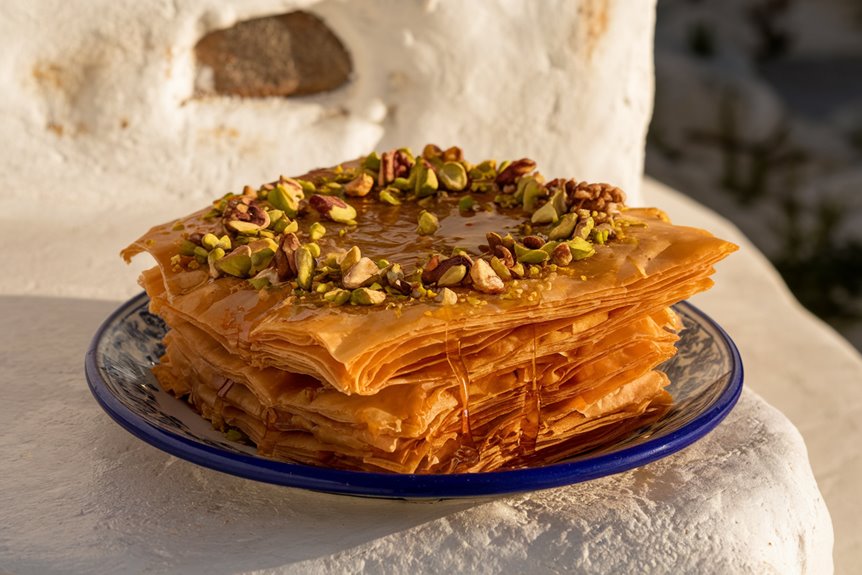
From tasty Spanish rice to sweet Greek puddings, homemade baklava is Greece’s favourite dessert. This rich treat has paper-thin phyllo pastry layered with chopped nuts – usually walnuts or pistachios – and loads of melted butter. Each layer gets a sprinkle of fragrant cinnamon and cloves before it’s baked until golden at 180°C.
The magic of baklava comes from its sweet syrup, which is just sugar, water, and honey, with a splash of lemon juice and sometimes orange zest thrown in. Greeks pour this cooled syrup over the hot pastry straight after it comes out of the oven. While Greek families stick to walnuts in their recipe, you’ll spot different versions around the region using other nuts or a touch of rose water to make it taste a bit different.
Creamy Italian Tiramisu

👉 Click here to get the recipe for:
The Creamiest Tiramisu Recipe You’ll Ever Eat (Straight out of Rome)
Italian Tiramisu is a real treat that’s become a favourite in cafes and homes all over Italy, especially in places like Venice and Treviso. While there’s a bit of friendly rivalry about where it started, this lovely pud is simply layered espresso-dipped ladyfingers, creamy mascarpone, and a light coating of cocoa powder.
- Try to find restaurants making their own tiramisu with proper ingredients like Marsala wine and fresh mascarpone
- The real deal should have clear, separate layers and the coffee shouldn’t be too strong
- Give the local twists a go, including versions made with gelato or semifreddo
- Pop into Treviso’s Le Beccherie or Tolmezzo’s Hotel Roma – both famous spots where tiramisu got its start
Every spoonful should be smooth and silky, with just the right mix of coffee, cream and sweetness.
Greek Island Spanakopita
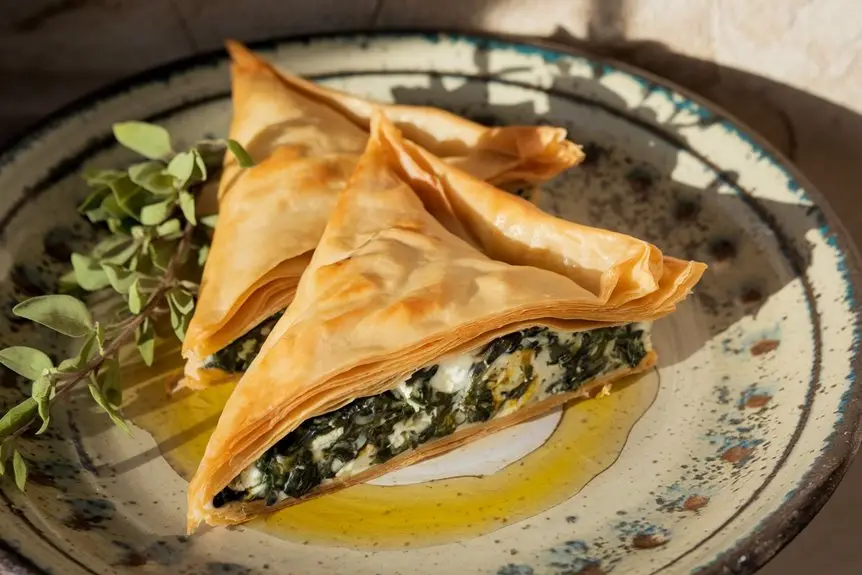
Spanakopita is one of Greece’s most-loved pastries, a brilliant mix of flaky phyllo layers and tasty filling that you’ll spot all over the Greek islands. This classic dish packs together fresh spinach, sharp feta cheese, and lovely herbs like dill and parsley, all tucked into delicate sheets of phyllo pastry brushed with olive oil.
As you wander through Greek ports, you’ll notice each island puts its own spin on it – some add nutmeg, bits of lemon zest, or mint to create different flavours. What makes the filling so moreish is how well the veg and cheese work together, whilst the outside gives you that lovely crunch.
It’s brilliant as a light lunch, snack, or alongside your dinner. If you’re on a Mediterranean cruise, make sure to try proper spanakopita – it really shows off what Greek cooking is all about.
Barcelona’s Crema Catalana
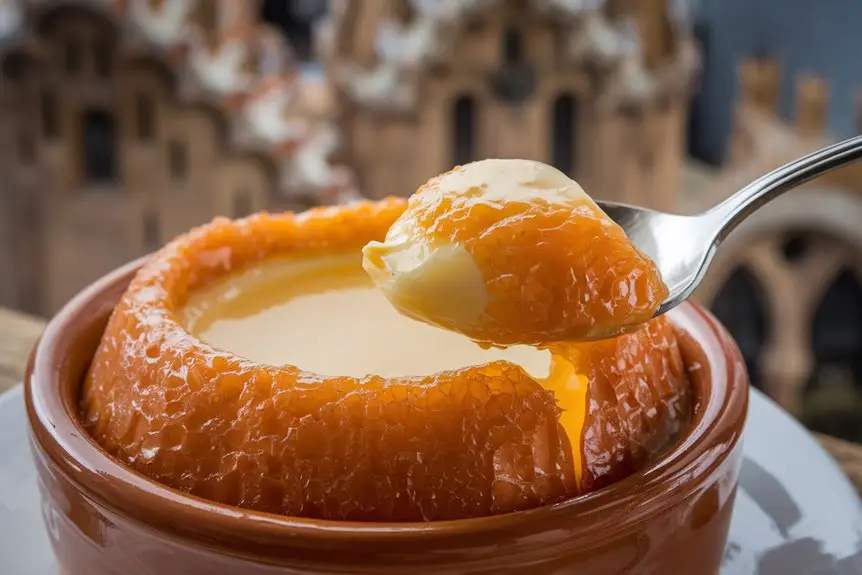
Barcelona’s sweet treats wouldn’t be what they are without Crema Catalana, a velvety custard that’s won over fans all around the Mediterranean. You’ll spot this proper Catalan pud served in clay pots, with its lovely smooth custard base filled with citrus and cinnamon flavours, and topped with a brittle sugar layer you can crack.
Want to eat it properly? Keep these tips in mind:
- Give the sugary top a good whack with your spoon – it should make a proper crack
- Head to the eateries near Barcelona’s Boqueria Market for the real deal
- You can taste the citrus and cinnamon that make it different from French crème brûlée
- If you’re stopping at port in Barcelona, get it as part of a set menu – it’s better value for money
Fresh Spaghetti Alle Vongole
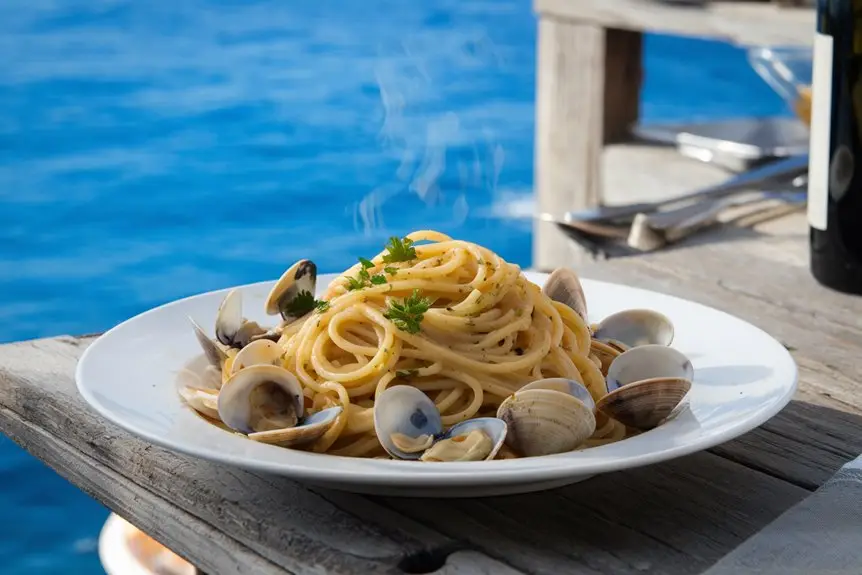
From Barcelona’s sweet treats to Naples’ seaside charm, you’ll spot Spaghetti alle Vongole as a favourite at many waterfront spots. This proper Neapolitan meal pairs fresh littleneck clams with perfectly cooked spaghetti in a light, tasty sauce.
In the kitchen, you’ll see the chefs frying garlic and shallots in extra virgin olive oil, then steaming the clams in dry white wine until they pop open, letting their salty flavours seep into the sauce.
When it lands on your table, you’ll find al dente spaghetti mixed with soft clams, some still in their shells, topped with fresh parsley. It only takes 30-45 minutes to make, but the local chefs have got the mix of flavours just right, thanks to years of cooking this well-loved seaside dish.
Premium Jamón Ibérico
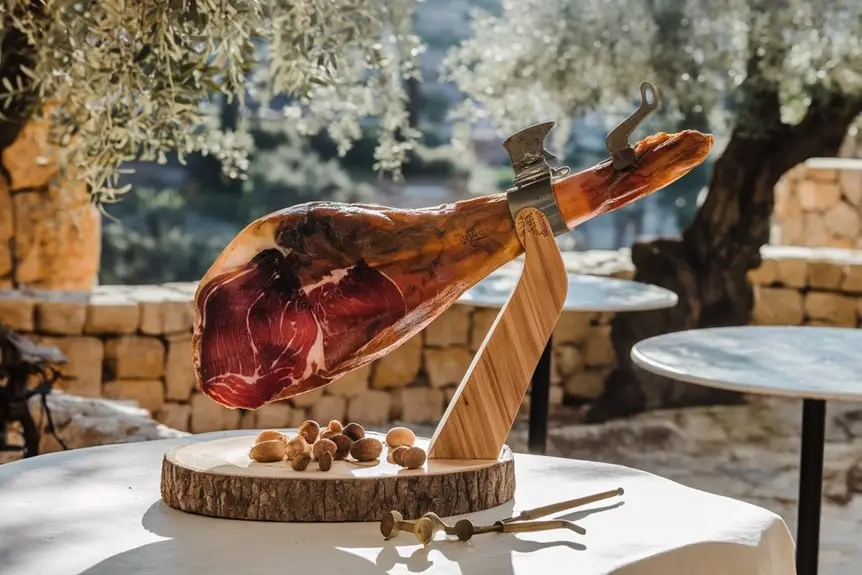
Spain’s top cured ham, Jamón Ibérico, is a proper treat you simply can’t miss. Whilst wandering through Mediterranean ports in Spain, you’ll spot this brilliant ham in places like Extremadura, Guijuelo, Jabugo, and Los Pedroches. What makes it so special? It’s all down to the native Iberian pigs that wander freely in the dehesa, munching on acorns from oak trees during their crucial fattening time.
The ham is rather brilliant because:
- It’s packed with healthy Oleic Acid – brilliant for keeping your cholesterol in check
- Pop it on the table and it starts melting, thanks to its special fat makeup
- Those acorns give it a lovely nutty, sweet taste
- Only the top 10% gets the fancy Jamón Ibérico de Bellota label
When you’re at port, keep an eye out for the smooth, marbled texture – that’s how you know you’ve got the good stuff.
Crispy Spanish Churros
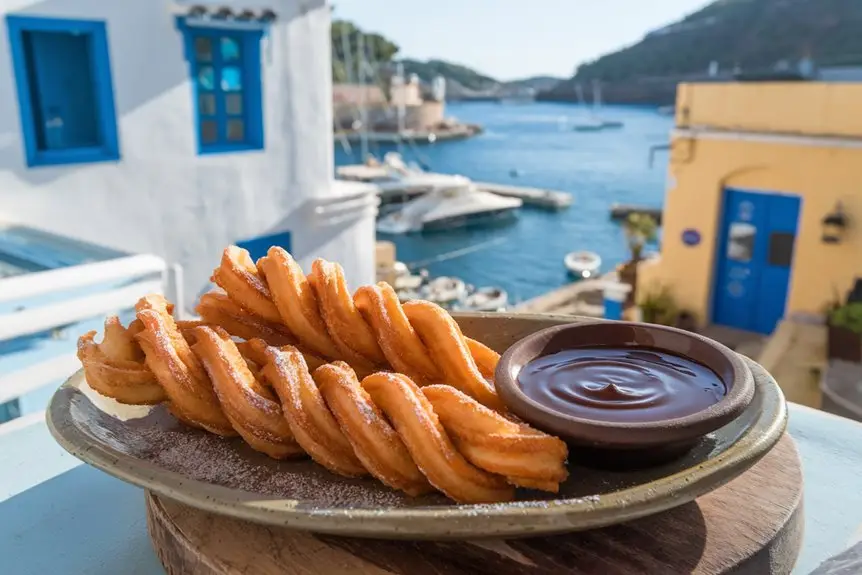
From hearty ham to sweet treats, Spain’s brilliant food scene just keeps giving. While you’re wandering through Spanish ports, you simply must try proper churros – these brilliant pastries started with shepherds who made simple fried dough up in the mountains.
You’ll spot these crispy treats at specialist churrerías like Madrid’s famous Chocolatería San Ginés or Barcelona’s Granja Viader. Unlike their international cousins, proper Spanish churros don’t have eggs or butter in them, which makes them extra crunchy. They’re made by squeezing a basic mix of flour, water, and salt into hot oil until they turn golden brown.
While some parts of Spain sprinkle them with cinnamon and sugar, the real magic is dunking them in thick, hot Spanish chocolate – it’s a beloved ritual that’s part of the culture now.
Middle Eastern Falafel

Get stuck into a crispy falafel at Mediterranean ports and you’ll see why this brilliant street food is loved across the Middle East. Whether you’re trying the Lebanese sort made with chickpeas or the Egyptian ta’miya made from fava beans, you’ll get a spot-on mix of fresh herbs, garlic, and aromatic spices. These golden-brown patties come tucked in warm pitas with tangy tahini sauce or sitting on fresh salads.
Want proper falafel? Keep these in mind:
- Go for places that make them fresh – proper falafel needs dried legumes, not tinned ones
- The outside should be crispy with a soft, herby middle
- Give both old-school and new versions a go to spot the differences between regions
- Have it with the usual bits like tahini sauce and fresh veg
Italian Gnocchi Alla Sorrentina
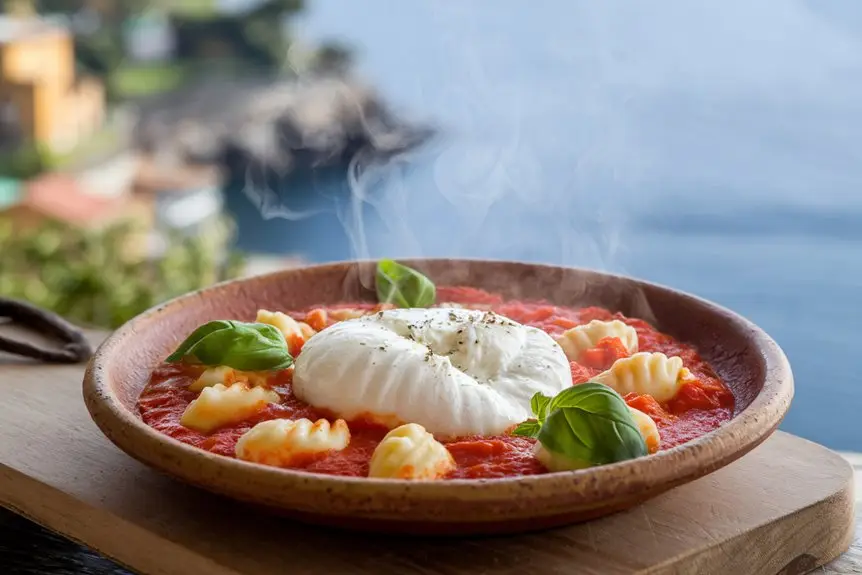
Along Italy’s Amalfi Coast, gnocchi alla Sorrentina is a brilliant example of the area’s fantastic cooking. It’s a proper warming meal that brings together soft potato gnocchi with a lovely rich tomato sauce, made from San Marzano tomatoes cooked with garlic and olive oil. The best bit? They pop fresh mozzarella from Campania and aged Parmigiano Reggiano on top, then bake it until it’s all golden and bubbling.
You’ll spot different versions across Italy, but Sorrento’s recipe is the one to beat. Local cooks take their time with the sauce, letting those little gnocchi dumplings soak up all the flavours before adding the area’s famous buffalo mozzarella. And mind you don’t forget the fresh basil on top – it’s not just there to look pretty, it really makes the whole dish sing.
Mediterranean Grilled Fish
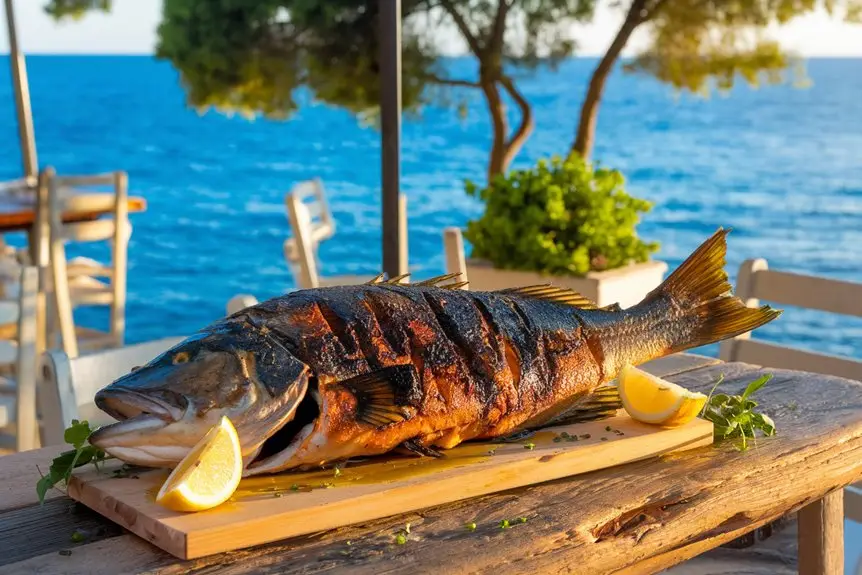
The Mediterranean’s got a brilliant way with grilled fish. Whether you’re bobbing along the coast or nipping into seaside towns, you’ll spot locals cooking up amazing seafood everywhere you go. From sea bass to branzino, each place does things a bit differently – the Turks love their aleppo chilli flakes, the Greeks can’t do without fresh herbs and lemon, and the Sicilians fancy a bit of saffron with theirs.
- Get your hands on whole Mediterranean sea bass, pop it on the grill with indirect heat and serve it with roasted spuds
- Pop into Naples for their daily catch – they really know their fish round there
- Give the grilled swordfish with caponata a go – it’s a proper Mediterranean classic
- Try the Turkish spin on things with red pepper paste and local spices
What makes Mediterranean fish so good? It’s simple really: top-notch seafood, good olive oil, fresh herbs, and a squeeze of lemon. That’s all you need.
Classic Amatriciana
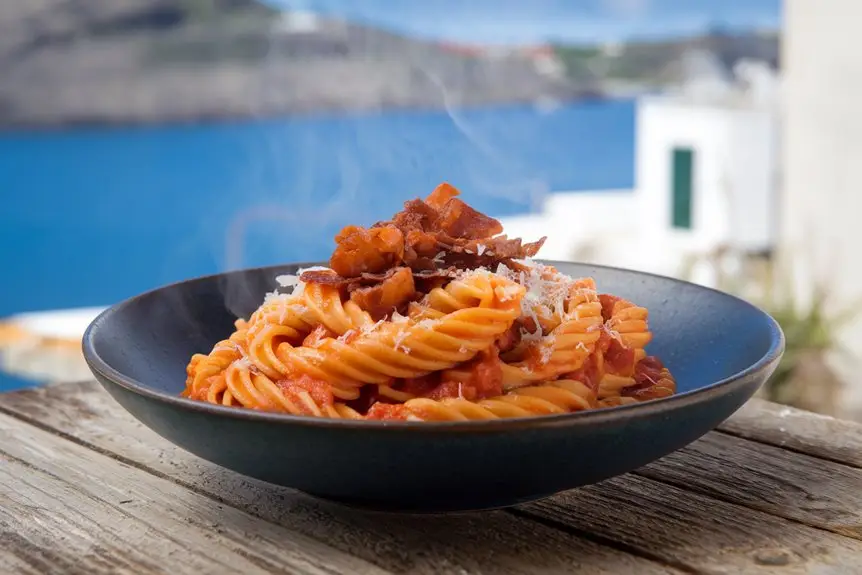
If you love Roman pasta, you’ll know Amatriciana is a real favourite in the city. Though it started in Amatrice, this brilliant pasta dish has become a Roman classic, made with bucatini in a rich sauce of guanciale, tomato passata and Pecorino Romano cheese.
The secret’s in how it’s made: you fry strips of cured pork cheek until they’re nice and golden, which gives the sauce its amazing flavour. While old-school recipes keep to these main ingredients, some places use spaghetti or rigatoni instead of bucatini.
When you’re after proper Amatriciana in Rome, try spots that stick to the traditional way: pasta cooked al dente, mixed through with the sauce, and topped with freshly grated Pecorino Romano. Most chefs add a bit of red chilli for some heat – that’s pretty standard.
Coastal Razor Clams
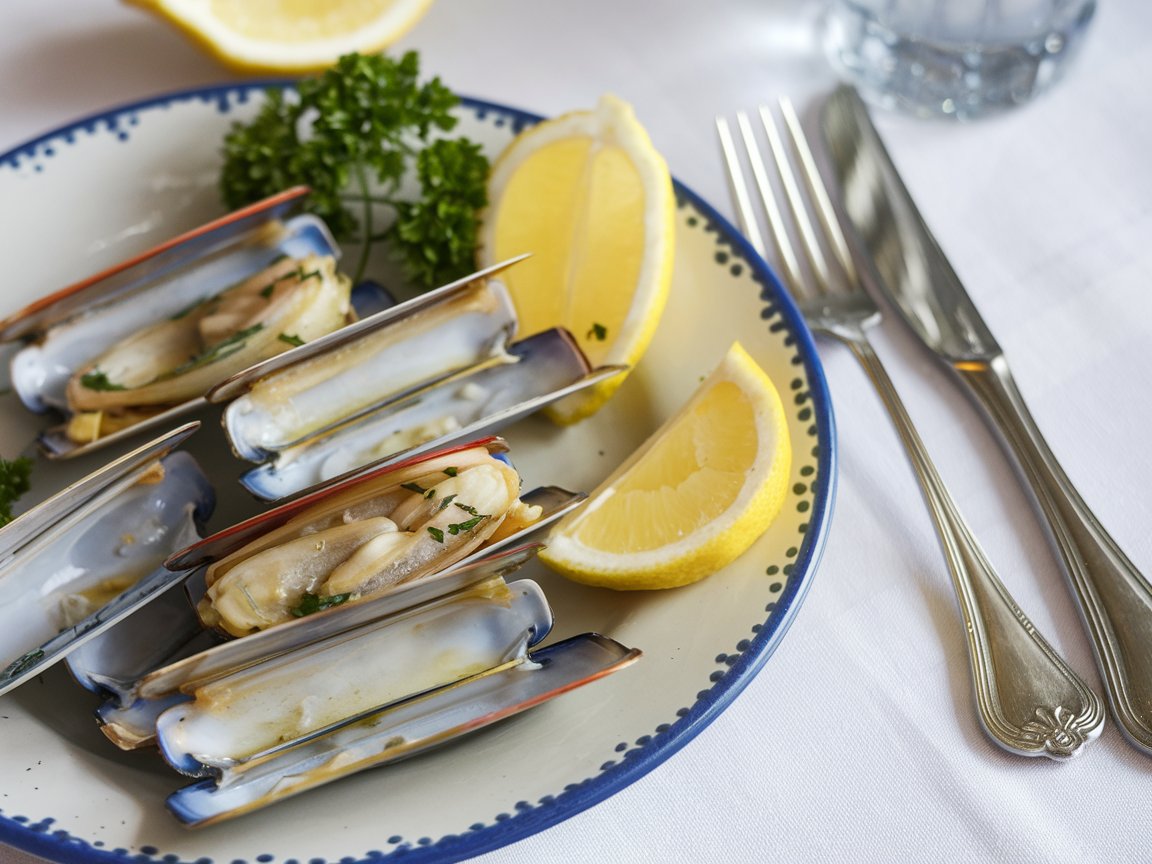
Coastal razor clams are some of the tastiest shellfish you’ll find along the Mediterranean. Local seaside restaurants know exactly how to cook them, sticking to time-tested methods that keep their natural sweetness. The Spanish way – a quick sear with garlic and parsley, plus a splash of lemon – is a favourite among locals.
- Soak them in salted water to get rid of any sand, then dry them properly before cooking
- Give them just a minute’s steam to keep them nice and tender
- Try cooking them in garlic butter and white wine for a proper Mediterranean meal
- You’ll spot them in coastal markets where locals bring in their morning catch
When you cook them right, these lovely shellfish give you a sweet, salty taste that’s purely Mediterranean.
Traditional Greek Salad
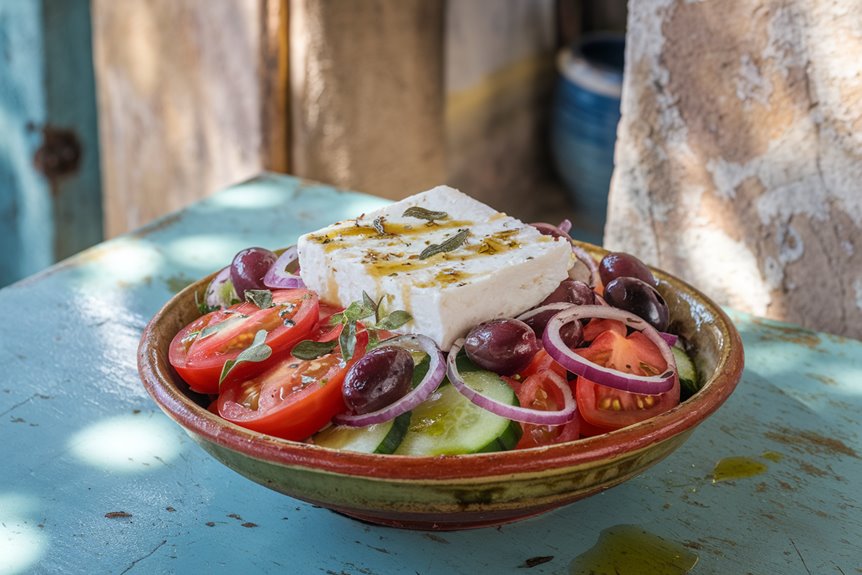
From garden-fresh to your plate, a proper Greek salad (horiatiki) is a brilliant Mediterranean favourite. You’ll spot these village salads in big portions at Greek ports, packed with chunky cucumbers, ripe tomatoes and crisp bell peppers. A hefty chunk of feta cheese rests on top of the veg, along with salty Kalamata olives and thin slices of red onion.
If you want the real deal, don’t look for lettuce – it’s just not part of it. The natural flavours do all the talking here. Your waiter will pour good olive oil and red wine vinegar over it, with a dash of oregano to finish. Grab some crusty bread on the side to mop up all the tasty juices that gather at the bottom of the bowl.
Savory Italian Saltimbocca
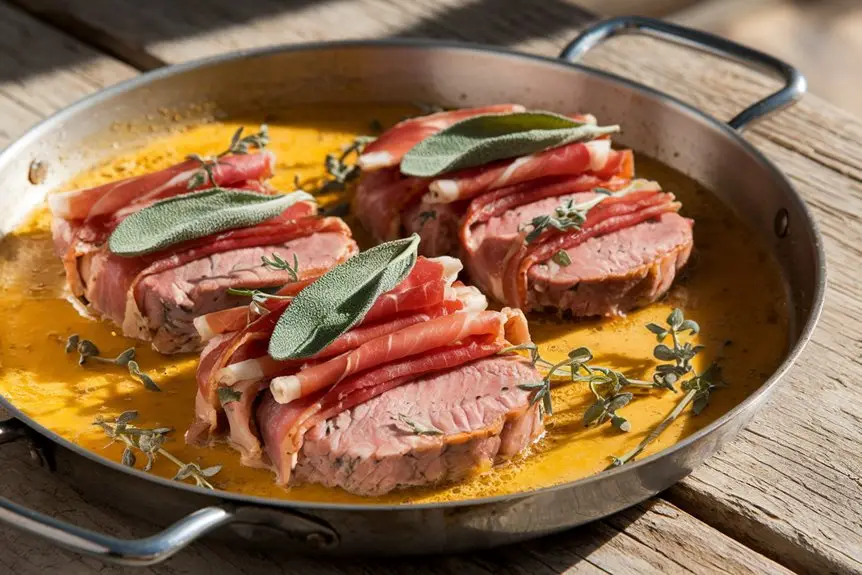
Coming across saltimbocca in Rome’s cruise port is a real treat – you’ll see it all over the local menus. This proper Roman favourite, meaning “jump in your mouth,” is made with veal cutlets topped with prosciutto and fresh sage leaves, and it’s absolutely mouth-watering. Watch the local chefs as they pound the meat until it’s nice and thin, add the good stuff on top, and cook it all up in white wine sauce.
- Go for the traditional veal if you want it proper Roman-style, though you can get chicken ones too
- Have a look at how well the prosciutto and sage leaves are fixed – that’s how you know it’s done right
- Keep an eye out for the light flour coating that makes it nice and golden
- Best enjoyed with some roasted potatoes and a bit of fresh lemon for the full Roman meal
Mediterranean Scampi
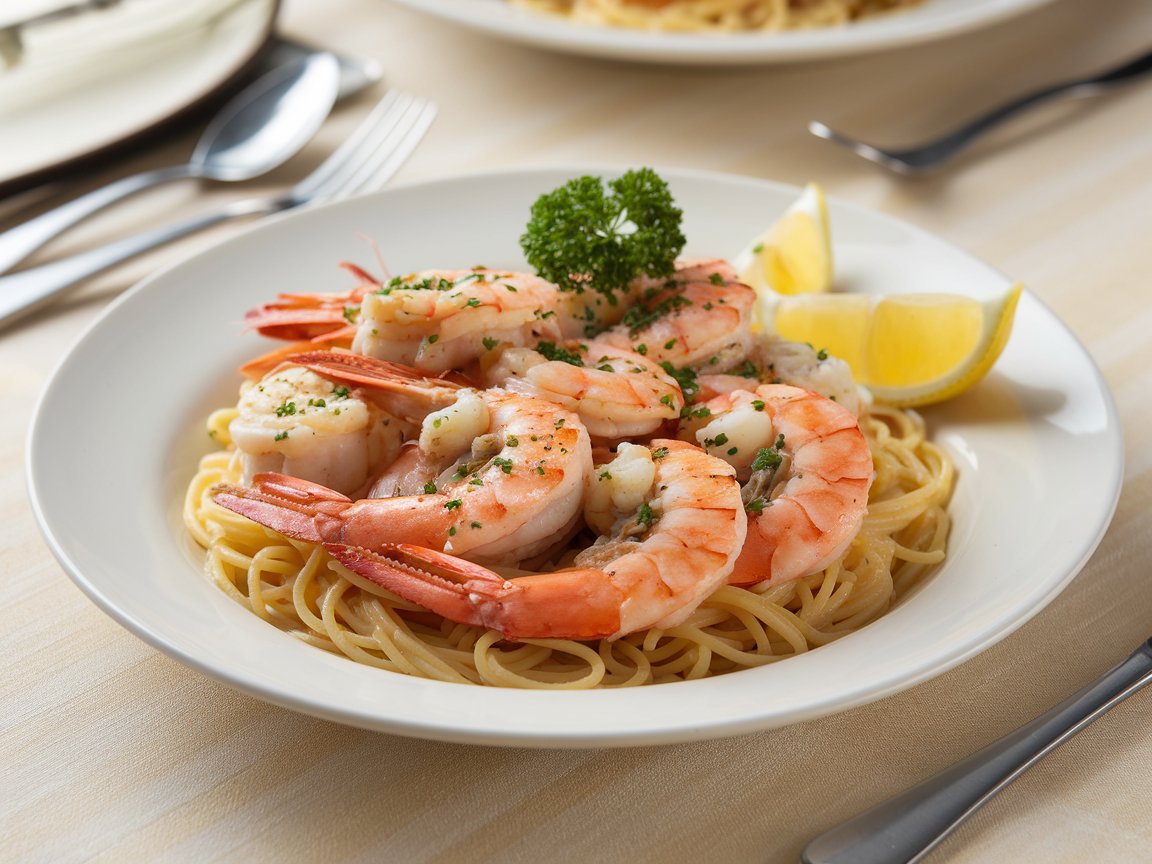
Along the Mediterranean coast, you’ll find scampi dishes that brilliantly show off the region’s punchy flavours. The traditional Italian way combines juicy prawns with a lovely sauce of garlic, butter, white wine, and fresh lemon juice. While the classic recipe is still tops with many, there are brilliant regional takes throughout Mediterranean ports.
In Greece, you might come across scampi jazzed up with salty feta and olives, while other local versions mix in fresh tomatoes and herbs from the area. Whether you’re having it on its own or with linguine, it’s brilliant how each port puts its own spin on it.
Give the versions with extra virgin olive oil a go, topped with fresh parsley and lemon zest. Since the dish is so flexible, you can try different styles as you move from port to port.
Local Anchovies
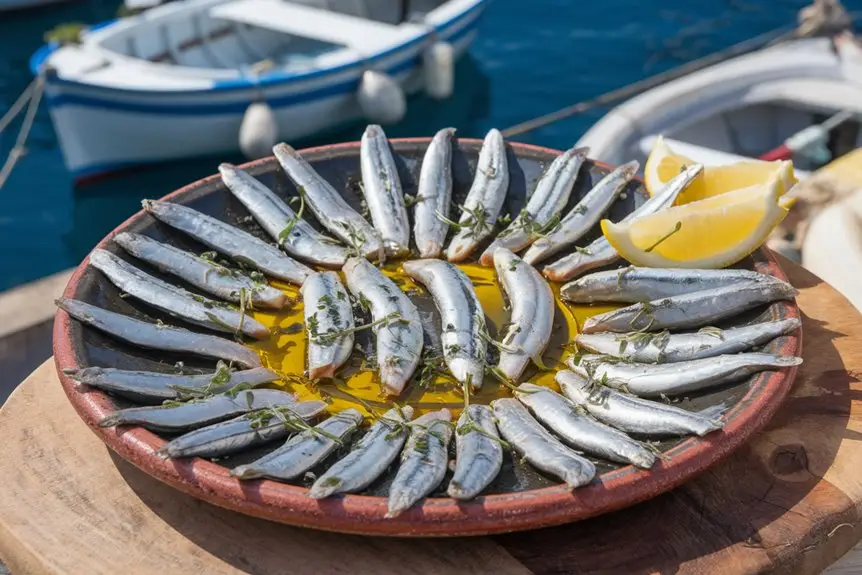
Fresh from the Mediterranean, local anchovies show how brilliantly this region handles its seafood, both in preserving and cooking. These little fish come prepared in age-old ways – from salt-curing to soaking in white wine vinegar and olive oil. Pop into local markets and restaurants to taste proper dishes like Greek-style baked anchovies with garlic and oregano, or roasted ones with a chunk of crusty bread.
- Go for fresh anchovies as meze or starters, often jazzed up with garlic, parsley, and lemon
- Give the Mediterranean marinated ones a try – they’re brilliant on pasta, salads, or crostini
- Have them baked in the oven at 190°C with local herbs and olive oil
- Find traditionally salt-cured anchovies that link back to ancient Roman garum-making methods
Gambas Al Ajillo
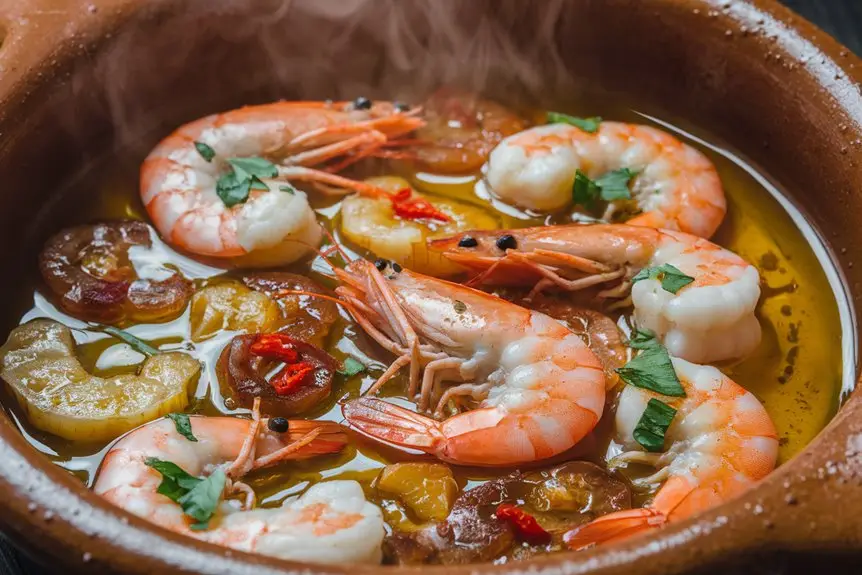
Straight from Madrid’s tapas bars, Gambas al Ajillo is Spain’s sizzling garlic prawn dish that’ll get your mouth watering. You’ll spot big prawns cooking away in a cazuela with loads of thinly sliced garlic, dried guindilla peppers, and sweet Spanish paprika, all swimming in top-notch olive oil.
The best bit? Mopping up all that tasty oil with chunks of crusty Spanish bread. Grab yourself a chilled glass of Albariño or Verdejo wine to go with it – they’re perfect together.
The dish comes out steaming hot with a sprinkle of fresh parsley on top, and it’s at its best when you tuck in straight away whilst the prawns are just right. For a proper tapas spread, get this alongside some Patatas Bravas or a classic Spanish tortilla.
Classic Italian Panna Cotta
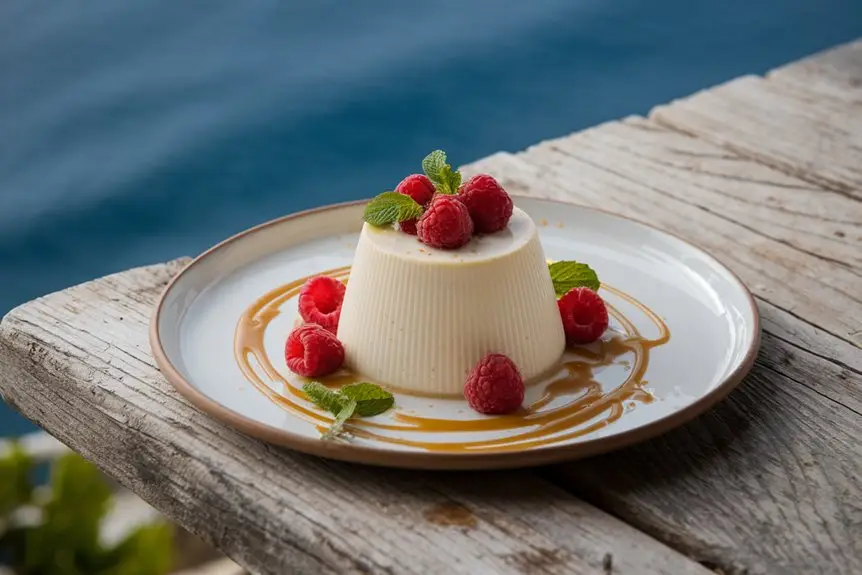
This lovely Italian pud is one of the Mediterranean’s favourite sweet treats. Made from cream, milk and vanilla, and set with gelatin, it’s wonderfully smooth. When it’s made properly, panna cotta should have a gentle wobble while keeping its shape – giving you a brilliantly creamy texture that melts as soon as it hits your tongue.
- A proper panna cotta should have gentle vanilla flavours and be pure white
- It shouldn’t be too firm – just stable enough to hold together when you turn it out
- The old-school way is to serve it with fresh berry sauce or local honey
- You’ll find brilliant versions in small, family-run Italian restaurants along the coast
It’s worth trying this classic dessert – goes really well with an Italian after-dinner drink or an espresso.
Traditional Italian Torrone
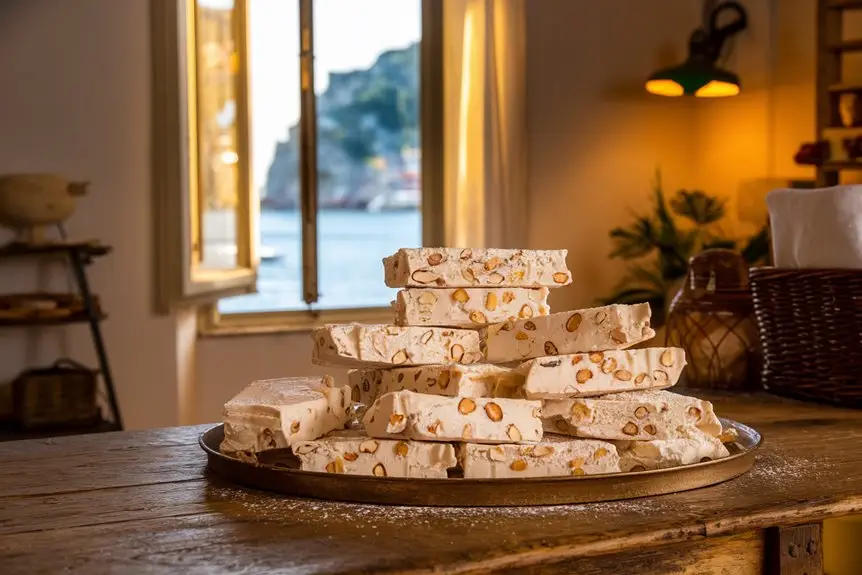
Torrone is a brilliant Italian sweet – it’s basically a nougat made from honey, egg whites and toasted nuts. You’ll come across two main types: soft and hard, and the difference comes down to how many nuts they use and how much water goes in. While almonds are the traditional favourite, you might spot some made with hazelnuts, pistachios or walnuts.
December’s your best bet if you want to try loads of it, though Italians eat it all year round. Want the real deal? Pop over to Cremona – they make half of Italy’s torrone there. The city puts on a proper celebration called Festa del Torrone, where you can try all sorts, from handmade to factory-produced versions of this centuries-old sweet. They’ve even got chocolate-covered ones and some stuffed with fruit.
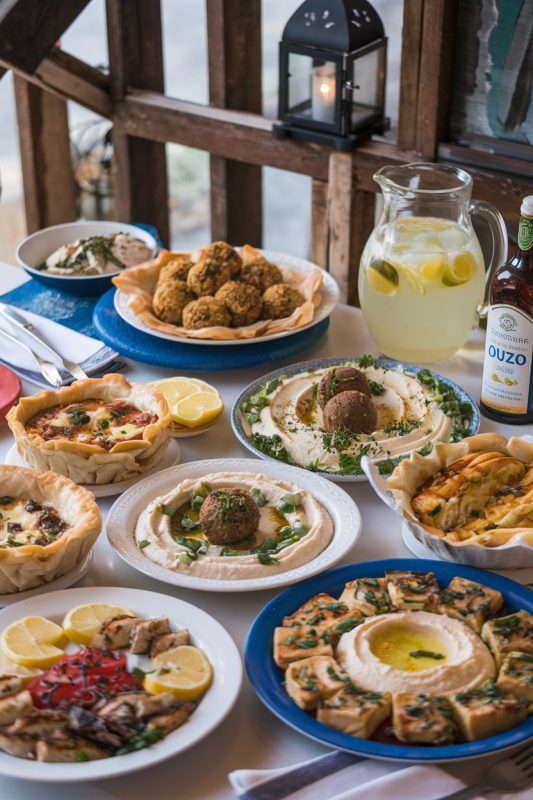
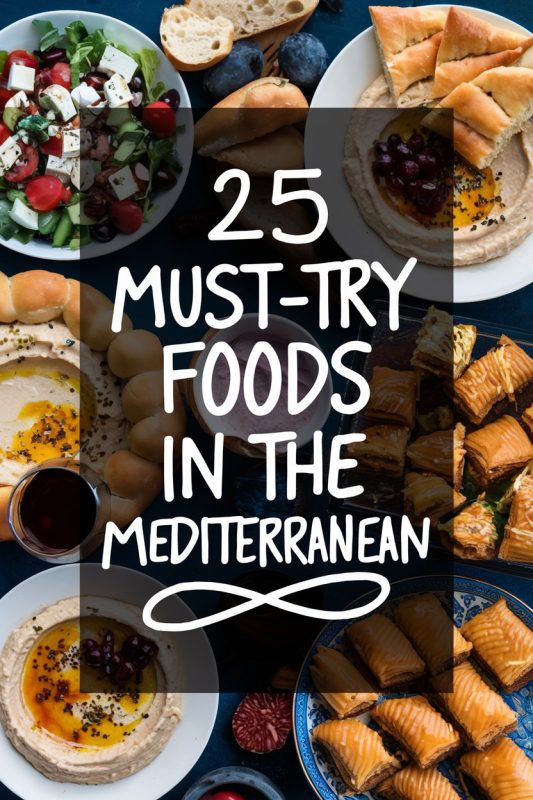
Frequently Asked Questions
What’s the Best Time of Year to Enjoy Fresh Seafood in Mediterranean Ports?
Fancy some tasty grilled octopus in Santorini? You can get brilliant seafood throughout the year, but springtime brings lovely sweet langoustines and tender baby calamari. If you’re heading to Mediterranean ports in summer, that’s when the prawns and swordfish are at their best.
Are Vegetarian Options Readily Available at Traditional Mediterranean Restaurants?
Mediterranean restaurants are brilliant for veggie food – you’ll spot loads of plant-based dishes wherever you go. Things like hummus, falafel and stuffed veg are absolutely standard on their menus. It’s just how they cook in that part of the world, with lots of fresh ingredients going into their meat-free meals.
How Much Should You Tip at Restaurants in Different Mediterranean Countries?
Handy to know – tipping is different everywhere! Leave about 5-10% in Greece and France, 10-15% in Turkey and Morocco, whilst in Spain you can just round up to the nearest euro. Look at your bill first though, as service might already be included.
Which Mediterranean Dishes Are Safe for People With Gluten Allergies?
Loads of Mediterranean food is naturally free from gluten – think grilled fish, Greek salads, hummus, tzatziki and dolmades. Go for meals that use rice, quinoa or veg instead of anything with wheat in it.
Can You Bring Food Purchased at Ports Back Onto the Cruise Ship?
You’re allowed to bring sealed, shop-bought food back on board the ship, but they won’t let you bring fresh fruit, veg or homemade bits and bobs. Best to keep it simple with packaged snacks and properly sealed items that match what your cruise line permits.
Get honest cruise advice that puts your interests first.
Jo and the About2Cruise team provide expert guidance to help you choose cruises based on reality, not marketing promises. Find out more about us.
